
Research Article
Austin J Plant Biol. 2015; 1(2): 1009.
Developing Cropping Sequence Options for Salt-Affected Rice-Based Production Systems in the Nile Delta and Iran
Dakheel AJ, Hussain IM* and Shabbir G
Department of Crop Diversification and Genetic Improvement Section, International Center for Biosaline Agriculture (ICBA), UAE
*Corresponding author: M Iftikhar Hussain, Department of Crop Diversification and Genetic Improvement Section, International Center for Biosaline Agriculture (ICBA), P.O. Box 14660, Dubai, UAE
Received: July 12, 2015; Accepted: December 08, 2015; Published: December 14, 2015
Abstract
The cropping cycles of the rice production systems take place from May to September in the Nile Valley and the Caspian Sea region of Iran. Farmers plant several traditional crops to fill the gap between two cycles to maximize productivity. However, in salt-affected areas crop selection and management must be adjusted to maintain favorable farm income levels. Two types of crops: A-fast-growing forages that can be planted in September and harvested in late November before the winter crops are sown and B-salt-tolerant crops that fit the whole period between two cycles are needed. Over the past few years, several production systems that fit these criteria have been evaluated at ICBA and at several national research system sites in the region. A large number of genotypes of fast-growing, salt-tolerant forages like barley, pearl millet, sorghum, fodder beet and forage brassica were evaluated at salinity levels up to 15 dS/m under field conditions. Nurseries of forage crops containing 25-30 genotypes/varieties with high yield potential under saline conditions were assembled and distributed to several national programs along with appropriate management packages. Similarly, ICBA developed nurseries of oilseed crops like safflower and canola to distribute to the selected farmers. ICBA also developed appropriate production and management packages that incorporate crop selection, irrigation and soil management and crop management practices for optimum production in salt-affected environments. These genotypes showed excellent tolerance to medium and highly salinity levels. Yield was decreased only by 12-15% at medium salinity (10 dS/m) and about 30% at high salinity (15 dS/m) level. Yield of brassica ranged from 16.8 to 29.8 T/ha, fodder beet above ground yield from 2.95 to 4.26 t/ha, fodder beet tuber yield from 7.14 to 12.08 t/ha and barley yield ranged from 7.6 to 10.6 t/ha at 5 ds/m and 15 dS/m respectively. The dry matter production of single cut and multi cut sorghum genotypes ranged between 11.1 and 31.9 and 5.4 to 7.9 t/ha respectively. The dry matter production of single cut and multi cut pearl millet genotypes ranged between 7.1 to 30.7 t/ha and 21.8 to 31.7 t/ha respectively. Continuous use of medium and high salinity water increased the soil salinity in the root zone (0-30 cm).
Keywords: Salt-affected rice systems; Short duration forages; Rice crop rotation; Forage production packages; Genotypes; Salt tolerant and salinity; Biomass
Introduction
Soil and irrigation water salinity has emerged as a stress and limiting factor to crop production especially in salt affected areas. Soil salinity is being progressively increased by irrigation and fertilization, especially in the arid and semi arid regions. Salts inhibit plant growth by osmotic stress, nutritional imbalance, and specific ion toxicity [1- 4]. It is estimated that more than 50 per cent of the irrigated lands in arid and semi-arid regions of the world are affected to some degree from salinization. About 21% of the world irrigated area was affected from soil salinity (Table 1). Millions of hectares of agricultural land have been abandoned because of salinity hazards. Besides, there are large areas, which are potentially vulnerable and could easily be damaged by salinization through irrigation. Rice (Oryza sativa) is the staple food for nearly half of the world’s population and a key source of employment and income for the rural people especially in developing countries. The crop occupies one third of the world’s total area planted by cereals. It is the most widely grown crop under irrigation. In 2002, 2.6% of the rice harvested area was located in the Near East Region. It is one of the major field crops in Egypt and occupies about 0.65 million hectares, produces approximately 6 million metric tons of rough rice annually and contributes about 20% to the per capita cereal consumption. The country has several production zones and ranks as one of the highest in the world in terms of productivity per unit area. It is also the second main crop consumed in Iran, after wheat. The production of paddy rice in Iran is currently around 2,000,000 tons from a cropped area of 533,000 hectares, all of which is irrigated. Barley is an important and one of the most salt-tolerant crop species among the glycophytes [5]. It is cultivated over a large area irrigated lands in the world. It has several, important economic and social benefits. It provides food for humans, feed for animals and poultry and raw material for malt industry. Canola can produce 1.0 to 2.0 tons of dry matter per acre in a single season.
Country
Area (Km2)
% of Irrigated land
India
70,000
17
China
67,000
15
Pakistan
42,000
26
US
42,000
23
Uzbekistan
24,000
60
Iran
17,000
30
Turkemenistan
10,000
80
Egypt
9,000
33
Suibtotal
281,000
21
World Est.
477,000
21
Source: F. Ghassemi, Jakeman AJ, Nix HA,"Salinization of Land and Water Resources", University of New South Wales Press, Sydney, 1995.
Table 1: Salt affected areas of different counties in the world.
Fodder beet is another highly productive and salt tolerant winter forage crop that can withstand salt stress during vegetative growth period [6]. It can be successfully grown in the salt-affected areas. Therefore it is cultivated in many countries around the world. Fodder beet roots are highly nutritious and contain much more sugar (150- 200 g kg-1 sucrose), total ash and crude fiber than yellow corn [7] which makes it a suitable alternative to cereal grains. The leaves and beet of the fodder beet contain a markedly lower sugar content compared to sugar beet [8] which is better for cattle health. Therefore, fodder beet is presently being used as an animal (camels, cows, and sheep) feed by local farmers in many countries of the world.
Sorghum (Sorghum bicolor (L.) Moench) and pearl millet (Pennisetum glaucum (L.) R. Br.) are among the most important warm-season grain and forage crops in the semi-arid tropical regions of Asia and Africa. They have wide agro-ecological adaptations, drought and salinity tolerance and excellent regenerative ability, permitting multi-cut forage production and grazing. Both the species have high Water-Use Efficiency (WUE), sorghum (27%) and millet (93%) when grown under water-limited environments. They are also highly heat tolerant, with pearl millet being the most tolerant up to 64oC [9]. Elite breeding lines, open-pollinated varieties and hybrid of pearl millet and sorghum have performed well at high salinity levels (15dS m-1) [10,11]. Rice based production system is increasingly under pressure of soil salinization due to poor drainage in rice fields which is leading to water logging, salinity, toxicity and water pollution that reduce the production potential of both land and water resources. Most of the countries in the Near East region are facing these problems. Global efforts are being made to combat and alleviate increasing salinization and sustainable integrated methods are being evaluated that can effectively be employed to these production systems. Several engineering and agronomic options have been used to manage salt-affected land; however, they are not always practical in all the areas. The development of salt-tolerant crop varieties is therefore a cost effective option in the management of salt-affected lands. The cropping cycles of the rice production systems in the Nile Valley and the Caspian Sea region of Iran take place from May to September.
There are several biophysical constraints associated with the development of sustainable cropping systems in the Nile Delta and Caspian Sea basin that include salinity, water logging, low soil organic matter and the declining soil fertility due to intensive mono-cropping. Meanwhile, lack of suitable crop rotation and poor land management has significantly affected soil productivity and fertility. Furthermore, with climate changes and population increase, there are increasing constraints in the Nile delta and Caspian Sea basin countries. In most irrigation systems, rice monoculture is the dominant practice. Farmers plant several traditional crops to fill the gap between two cycles to maximize farm productivity and stabilize their incomes. While profits from rice culture are very low and declining, a diversified agriculture will be more sustainable in the long run. Sustainable crop management practices have been evaluated recently. Proper soil management, selection of suitable crops and crop varieties, and the use of water management technology have proved a potential to influence the cropping systems’ productivity and sustainability in a positive way.
Present rice culture systems require more water than most other food crops in terms of food and calories produced. There is a scope for increasing returns from land and water by growing diversified crops. However, in salt-affected areas crop selection and management must be adjusted to maintain favorable farm income levels. Farmers should be provided with facilities to exercise crop choice options, which is presently lacking in several systems. The main objective of this component of the present project is to identify suitable crop species/ genotypes that are more productive under high salinity conditions, encountered in the rice cropping system during the off season period. Such crops are targeted to fill the gap in between two rice cropping cycles or to be used as rotational crops. As several crop species have the potential to be utilized in the rice based production system, the present paper is concentrating on testing the crop species like barley, brassica/rape, fodder beet, pearl millet, sorghum and other crops.
Material and Methods
The research was conducted in experimental field station of International Centre for Biosaline Agriculture (ICBA), Dubai, U.A.E. situated at 25°, 13’ N and 55° 17’ E. The soils of the experimental site is Typic Toripsamment, mixed hyperthermic), sandy with poor nutrient availability and mainly irrigated through drip irrigation system. Fodder beet and forage rape/brassica varieties were acquired from international seed companies. Fodder beet, rape/brassica, seeds were sown in rows keeping R X R distance 50 cm and P X P distance 25 cm. Three salinity levels of irrigation water (5, 10 and 15 dSm-1) were developed by mixing brackish ground water (EC approx. 22 dS m-1) with desalinated fresh water and applied as salinity treatment. Varieties/genotypes were nested in sub-plots inside each whole plot. Each genotype was repeated three times in each salinity treatment.
Salinity was tested and monitored three times a week with an EC meter (WTW TetraCon® 325 Cond 197i). An automated drip irrigation system was installed for irrigation. Each irrigation cycle consisted of four applications of 15 minutes, giving a discharge of 4 l/ m2 /day/dripper. Fresh water was used at germination and early growth stages to get a good crop stand then irrigation with saline water was started that was continued throughout the growing period. Standard agronomic practices were followed throughout the experiment. Data on forage production were recorded when plants had reached to full growth. For above ground biomass all the aerial plant parts were cut and fresh weight was recorded immediately in the field. Sub samples were drawn into paper bags and kept in a forced air oven at 60oC for 72 hours to get uniform dry weight. For tuber yield of fodder beet, plants were dug carefully with hand tools without cutting the tubers. Tubers were washed and weighed immediately in the field for fresh weight. The tubers were cut longitudinally into two halves and sub samples were drawn. The dry matter yield of tubers was measured similar to above ground biomass as described above. Seeds of sixty four barley accessions (thereafter called genotypes) were obtained from ICARDA. More than 800 accessions (genotypes) of pearl millet and sorghum were obtained from ICRISAT and screened during the past years. These genotypes were evaluated at ICBA at three salinity levels under field conditions and nurseries of salt tolerant genotypes were assembled for further evaluation and farmers field trials at other locations in partner countries.
Thirty genotypes of each of pearl millet and sorghum were selected and evaluated at ICBA. Fodder beet, rape/brassica, pearl millet and sorghum seeds were sown in rows keeping R X R distance 50 cm and P X P distance 25 cm. Barley seeds were sown in 50 cm apart lines. Three salinity levels of irrigation water (5, 10 and 15 dS m-1) were developed by mixing brackish ground water (EC approx. 22 dS m-1) with desalinated fresh water and applied as salinity treatment. Salinity was tested and monitored three times a week with an EC meter (WTW TetraCon® 325 Cond 197i). An automated drip irrigation system was installed for irrigation. Each irrigation cycle consisted of four applications of 15 minutes, giving a discharge of 4 l/m2 /day/dripper. Fresh water was used at germination and early growth stages to get a good crop stand then irrigation with saline water was started that was continued throughout the growing period. Standard agronomic practices were followed throughout the experiment
Data on forage production were recorded when plants had reached to full growth. For above ground biomass all the aerial plant parts were cut and fresh weight was recorded immediately in the field. Sub samples were drawn into paper bags and kept in a forced air oven at 60°C for 72 hours to get uniform dry weight. For tuber yield of fodder beet, plants were dug carefully with hand tools without cutting the tubers. Tubers were washed and weighed immediately in the field for fresh weight. The tubers were cut longitudinally into two halves and sub samples were drawn. The dry matter yield of tubers was measured similar to above ground biomass as described above.
The experiments were laid out in a split-plot design with three replications. Salinity levels were the main plots and genotypes the sub-plots. Variation within and among treatments was evaluated via Analysis Of Variance (ANOVA). A univariate general linear model was used for ANOVA. Normality of the data was determined from Q-Q plots and equality of variances was determined from Levene’s Test (P < 0.05). Mean comparison of the treatments was performed on using Tukey Honestly Significant Difference (Tukey’s HSD) test (P < 0.05). All the statistical analyses were performed using different modules of SPSS software (Table 2).
Variable
Source
Mean Square
F
Sig.
Green fodder yield (T/ha)
Salinity
890.6*
246.3
0.000
Variety
465.6*
25.8
0.000
Salinity*Variety
29.5ns
1.6
0.125
Error
18.1
Dry matter yield (T/ha)
Salinity
45.69*
41.19
0.002
Variety
12.49*
15.23
0.000
Salinity*Variety
2.52*
3.01
0.005
Error
0.82
*= mean squares are significant (a =0.05)
Table 2: Significance of mean square and F probability of varieties and salinity for fresh yield (T/ha) of rape/brassica varieties.
Results and Discussion
Case study - Rape/brassica
Rape/Brassica yield under improved production technology package at ICBA Research Station site are presented in (Figures 1-4). Green fodder yield was decreased up to 19.1% and 43.6% and dry matter yield was decreased by 15.2% and 47.3% at medium and high salinity levels respectively. The significant differences among the variety means for fresh and dry matter yield showed large genetic variation for fodder production. Interaction between salinity and verities for fresh yield was absent but significant interaction was present for dry matter production. Variety 98-D produced the highest fresh yield comparing with the lowest yield of Hyola-405. The yield of 98-D was at par with Hyola-60. The Hyola-61 produced the lowest dry matter compared to all other varieties.

Figure 1: Green fodder yield of brassica varieties at three salinity levels.
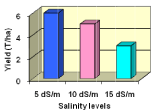
Figure 2: Dry matter yield of brassica varieties under three salinity levels.

Figure 3: Green fodder yield of brassica varieties at three salinity levels at
ICBA-2007.

Figure 4: Dry matter yield of brassica varieties at three salinity levels at ICBA-
2007.

Figure 5: Above ground green forage production of fodderbeet varieties at
three salinity levels.

Figure 6: Below ground green forage production of fodderbeet varieties at
three salinity levels.
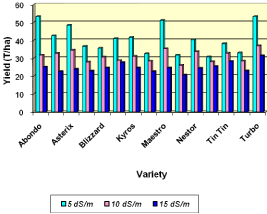
Figure 7: Above ground green forage production of fodder beet varieties over
three levels.

Figure 8: Below ground green forage production of fodder beet varieties over
three salinity levels.

Figure 9: Above ground dry matter production of fodderbeet varieties at three
salinity levels.

Figure 10: Below ground dry matter production of fodderbeet varieties at
three salinity levels.

Figure 11: Above ground dry matter production of fodderbeet varieties at
three salinity levels.

Figure 12: Below ground dry matter production of fodderbeet varieties at
three salinity levels.
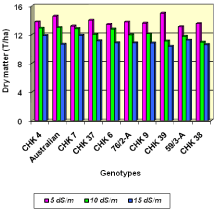
Figure 13: Dry matter production of ten yielding barley genotypes at three
salinity levels.

Figure 14: Seed production of ten high yielding barley genotypes at three
salinity levels.
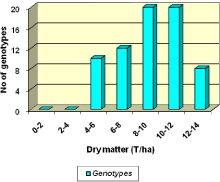
Figure 15: Range of dry matter yield of barley genotypes at three salinity
levels.

Figure 16: Range of seed yield of barley genotypes at three salinity levels.

Figure 17: Dry matter production of top ten single cut PM genotypes at three
salinity levels.
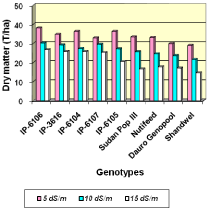
Figure 18: Dry matter production of multi cut PM genotypes at three salinity
levels.

Figure 19: Dry matter production of single cut sorghum genotypes at three
salinity levels.

Figure 20: Biomass production of multi cut sorghum genotypes at three
salinity levels.
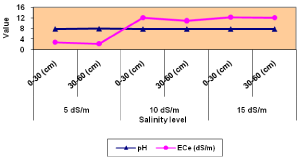
Figure 21: pH and ECe of soil in fodder beet field after irrigation with three
salinity waters for one crop season.
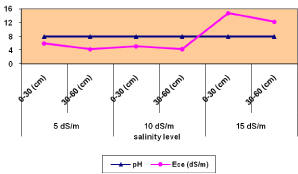
Figure 22: pH and ECe of soil under barley field after irrigation with three
salinity waters for one crop season.
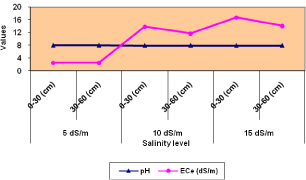
Figure 23: pH and ECe of soil under brassica field under irrigation with three
salinity waters for one crop season.
Case study - Fodder beet
Results of analysis of variance, for above ground fresh forage yield, below ground fresh weight, above ground dry matter, and below ground dry matter of fodder beet are presented in (Table 3). The results of ANOVA indicate that salinity and variety means were highly significant for all the variables. There was no evidence of interaction between salinity and varieties except tuber fresh weight as indicated by significant results for salinity x variety interaction. Maximum fodder production (above ground and below ground yield) was achieved at low salinity levels (5 dS m-1). Above ground fresh forage yield was dropped by 39% and 24% and tuber fresh yield by 45.8% and 20.6% at high and medium salinities respectively. Above ground dry matter yield was dropped by 30.8% and 16.2% at high and medium salinity levels respectively. Medium and high salinity had a similar effect on tuber production and tuber dry matter yield was declined by 36.7% at these salinity levels compared to low salinity.
Variable
Source
Mean Square
F
Sig.
Above ground green forage
Salinity
2889.8*
30.7
0.00
Variety
146.8*
4.8
0.00
Salinity * Variety
42.9ns
1.4
0.12
Error
30.4
Below ground green forage
Salinity
27501.1*
78.8
0.00
Variety
423.5*
7.0
0.00
Salinity * Variety
181.4*
3.0
0.00
Error
60.1
Above ground Dry matter
Salinity
19.3*
10.4
0.026
Variety
1.5*
3.3
0.000
Salinity * Variety
0.6ns
1.4
0.145
Error
0.5
Below ground Dry matter
Salinity
314.2*
30.5
0.004
Variety
12.7*
3.0
0.001
Salinity * Variety
3.6ns
0.8
0.690
Error
4.3
*= mean squares are significant (a =0.05)
ns= Mean squares are non significant (a =0.05)
Table 3: Mean square and F probability of salinity and variety for above ground and below ground green and dry weight (T/ha) of fodderbeet.
Varieties also showed a wide genetic variation among themselves.
Above ground fresh forage yield varied between 26.2 to 40.6 t ha-1 and fresh tuber yield ranged between 74.1 to 95.2 t ha-1. Turbo produced the highest green forage (40.6 t ha-1) and Kyros produced the highest tuber yield (95.2 t ha-1). Above ground dry matter yield varied between 2.8 to 4.3 t ha-1 and tuber dry matter yield ranged between 6.7 to 10.9 t ha-1. Turbo produced the highest above ground green forage (40.6 t ha-1) as well as above ground dry matter (4.3) and Kyros produced the highest tuber yield (95.2 t ha-1) but highest tuber dry matter was produced by Blizzard (10.9). Results of forage production of fodder beet varieties are demonstrated in (Figures 5-12).
Case study - Barley
Results of analysis of variance of biomass and seed yield are presented in (Table 4). The ANOVA results indicate that salinity had a significant effect on biomass and seed production. Genotypes showed considerable genetic variability with respect to biomass and seed yield. There was no interaction between salinity levels and genotypes. Maximum yield was obtained at low salinity level (5 dS m-1) compared with the lowest yield at high salinity level (15 dS m-1). Total biomass production was decreased by 28.3% and 13.2% at medium high salinity levels. Salinity also had a profound effect on the seed yield which was reduced by 38% and 19% at high and medium salinity levels. Biomass production varied between 4.5 t ha-1 to 12.9 t ha-1 whereas, seed yield ranged between 0.46 - 5.62 t ha-1. CHK-4 produced the highest biomass and CHK-7 produced the highest seed.
Dry matter yield
Source
df
Mean Square
F
Sig.
Salinity
2
471.8*
1661.48
0.00
Genotype
69
47.3*
41.98
0.00
Salinity * Genotype
138
1.3ns
1.24
0.06
Error
414
1.13
Seed yield
Salinity
2
986532.2*
496.84
0.00
Genotypes
63
201007.5*
47.48
0.00
Salinity * Genotypes
125
4471.2ns
1.06
0.34
Error
370
4233.14
*= Mean squares are significant (a =0.05)
ns= Mean squares are non significant (a =0.05)
Table 4: Degrees of freedom, mean square and F probability of varieties and salinity for total biomass and seed yield.
Biomass and seed production of ten high yielding barley genotypes has shown in (Figures 13 & 14) and range of biomass and seed production of the genotypes has shown in (Figures 15 &16) respectively.
Pearl millet and sorghum screening
More than 800 genotypes of pearl millet and sorghum were screened at ICBA at various salinity levels up to 15 dS m-1 (11,000 ppm). These genotypes were B lines, elite genotypes, varieties, landraces and mapping populations. Dry matter yield range of B Lines varied between 10 and 72 g/plant. Mean dry matter production of Elite genotypes ranged between 56 and 11 g/plant, landraces 7 and 116 g/plant and mapping populations 19 to 90 g/plant. The range of dry matter production of sorghum genotypes screened varied between 3 to 70 g/plant, respectively. High yielding genotypes were selected based on their performance during screening trials and nurseries of 25-30 genotypes were assembled. The selected genotypes were grown at three salinity levels under field conditions at ICBA in 2006. Results of biomass production of pearl millet and sorghum in 2006 are described as under.
Case Study -Pearl millet
Results of forage production of pearl millet based on dry matter yield as single and multi cut crops are presented from (Table 5). Results of ANOVA of pearl millet single cut and multi cut (Table 5) indicate that mean differences among salinity levels and genotypes were significant. Higher salinity levels had significantly reduced the dry matter production of pearl millet as single cut crop. Maximum yield was obtained at lowest salinity level (5 dS m-1) and vice versa. Yield was decreased by 20.9% and 39.1% at 10 dS m-1and 15 dS m-1 respectively. Low tolerant genotypes had an average yield of 10 t ha-1 and the medium tolerant genotypes had 18.6 t ha-1 dry matter. The comparative yield decrease of low and medium tolerant genotypes to highly tolerant genotypes was by 64.2% and 34% respectively. Like single cut, salinity had a significant effect on the pearl millet multi cut crop. Maximum dry matter (33.78 t ha-1) was produced at 5 dS m-1. Dry matter yield was reduced by 37.8% and 21.3% at high salinity (15 dS m-1) and medium salinity (10 dS m-1) respectively. The lowest yielding variety Shandwel had a dry matter yield 21.8 t ha-1 i.e. 31% lower than IP6106, the highest dry matter producer (31.7 t ha-1). Results of dry matter production of ten high yielding pearl millet genotypes as single and multi cut crop at three salinity levels are presented in (Figures 17 & 18).
Variable
Source
df
Mean Square
F
Sig.
Single cut
Salinity
2
1666.9*
107.8
0.00
Genotype
29
397.6*
26.5
0.00
Salinity * Genotype
58
17.3ns
1.2
0.24
Error
174
15.0
Multi cut
Salinity
2
1084.0*
54.8
0.00
Genotype
8
101.7*
4.9
0.00
Salinity * Genotype
16
9.6ns
0.5
0.95
Error
48
20.7
*= Mean squares are significant (a =0.05)
ns= Mean squares are non significant (a =0.05)
Table 5: Degrees of freedom, mean square and F probability of genotypes and salinity for dry matter yield of pearl millet as single cut.
Case study - Sorghum
Statistical results of sorghum genotypes as single and multi cut are presented in (Table 6). The ANOVA results indicate that means of salinity as well as genotypes were significant at a < 5%. Dry matter yield of single and multi cut crops was reduced with increased level. Maximum dry matter was obtained at lowest salinity level (5 dS m-1). Yield was decreased by 16.34% and 26.4% at 10 d Sm-1and 15 dS m-1 respectively. Wide genetic variation was found among genotypes for dry matter production. Low yielding genotypes had an average yield of 13.3 t ha-1 and the medium tolerant genotypes had 20.2 t ha-1 dry matter. The average yield of low and medium tolerant genotypes was decreased by 57.1% and 34.8% respectively. Salinity had affected the yield of multi cut sorghum genotypes as well. Maximum dry matter (8.5 t ha-1) was produced at 5 dS m-1. Dry matter yield was reduced by 41.2% and 24.8% at high salinity (15 dS m-1) and medium salinity (10 dS m-1) respectively. SP-39262 had the lowest dry matter yield 5.4 t ha-1 i.e. 31% lower than Pioneer, the highest forage producer (7.9 t ha-1). Results of biomass production of ten high yielding single cut sorghum genotypes and multi cut genotypes are presented in (Figures 19 & 20).
Effect of saline irrigation on soil properties
Soil samples were collected after harvesting each crop and analyzed for ph and EC to see the effect of saline water irrigation on the soil properties. The results of ph and ECe of soil under fodder beet, canola and barley crops are presented in (Figures 21-23) as under. The results indicate that pH of the soil under each crop was not substantially affected. However, saline irrigation had a clear effect on the EC. EC was higher in the 0-30 cm depth than 30-60 cm. EC was much higher in medium (10 dS m-1) and high (15 dS m-1) salinity plots than low salinity (5 dS m-1) plots. EC of soils under brassica crop was higher than barley and fodder beet. Effect of medium and high salinity water on the soil EC was similar under fodder beet crop. In barley field effect of low and medium salinity water was not significantly different however, soil under high salinity irrigation become highly saline. Salinity of soil under brassica crop increased linearly with increase in irrigation water salinity. The trend in soil salinity is confirmed with the decline in the fodder yield of these crops under respective salinity levels.
Discussion
Varieties and genotypes of fodder beet, fodder brassica, barley, pearl millet and sorghum were evaluated under field conditions for fodder production at three salinity levels of irrigation water. Wide range of phenotypic and genetic variation was observed among genotypes of all the crops. Fodder yield of all the crops was reduced at increasing salinity level. The yield in general was reduced up to 12- 15% at medium and up to 30% at high salinity levels. According to the U.S. Salinity Laboratory Staff (1954), forage crops with medium salt tolerance range from an EC of 4 to 12 dS m-1 for a 50% decrease in yield compared to yields on nonsaline soils under comparable growing conditions. On the basis of this criterion we may consider these species as medium tolerant to soil salinity.
Different cultivars of canola are different in their degree of sensitivity to salinity and vary in their seed requirement under salt stress conditions [12] (Puppala et al., 1999). The brassica/rape cultivars, we studied, showed a significant variation to salt stress. Dry matter yield varied from 14.5 - 33.5 t ha-1. The varieties can be divided into medium and high salt tolerant based on their yield potential at three salinity levels. Effect of salinity was more evident on stem and leaf yield of fodder beet than tubers. This shows sensitivity of above ground parts of fodder beet more than tubers. Sugar beet is very salt tolerant which is not affected even at NaCl level of 350 mmol [13] (Papp et al., 1983). Although fodder beet varieties performed well over all the salinity levels, the tuber yield was reduced more than 50% when compared with fresh water yield (35-45 t ha-1/year). However, overall leaf and stem yield was comparable with fresh water yield (6-7 t ha-1/year) (Belal 2007) [14].
Barley has been proven to be adapted to saline conditions and tolerant of salinity and it could provide an alternative which would maintain an adequate level of forage quality for livestock operations [15] (Todd 2006). Barley genotypes produced promising yields under saline conditions and showed and wide range for forage production. Some of the genotypes performed even better than checks as well as commercial varieties. Although the genotypes maintained acceptable yield levels at medium and high salinity, the yield was decreased with an increased in salinity level. These findings are consistent with Maas and Hoffman (1977) [16] who found that as salt levels increased above threshold levels, the growth rate and size of the plant decreased. Specifically, a 7.1 unit decrease in barley forage for every unit increase above the salinity threshold. Grain yield was also affected by salinity and declined with elevated saline irrigation. This concurs with Majerus, [17] (1996) who stated that productivity of barley grain will decline at salt levels of 7 dS m-1. Threshold levels of 1.2 dS m-1 and SAR of 35 are much lower to test forage yield of barley than for grain, and also elevated SAR has an impact on forage yield [15] (Todd 2006). It is well accepted fact that if soil salinity surpasses a certain threshold level, crop growth, yields and quality are reduced [18, 19] (Maas 1993; Netondo et al., 2004a). Our results showed an agreement with these findings. The yield of both sorghum and pearl millet genotypes was linearly decreased with an increase in irrigation water salinity. The yield of pearl millet was affected more than sorghum under similar salinity levels as single cut crop. The integration of appropriate sorghum and pear millet varieties, which may provide direct benefits from otherwise unproductive areas, could offer an additional income generation to producers in salt-effected environments [20]. Although wide genetic differences were found for dry matter production among genotypes of both the species, some of the genotypes maintained a stable yield across all the salinity levels, emphasizing the potential of these genotypes to be grown in marginal and salt affected fields. Both pearl millet and sorghum exhibited the ability to regenerate after cutting regimes showing that they can be grown as multi cut crops.
Irrigation with saline brackish water negatively affects the soil properties. Around 6% of the global land area suffers from salinization due to natural causes or irrigation, posing a major strain on agricultural production. It is estimated that irrigation related salinization leads to the abandonment of 107 hectares of agricultural land annually [21]. Continuous use of saline water for irrigation leads to develop excessive salts in the root zone that would ultimately result into significant yield losses. Our findings indicate that irrigation with saline water for one cropping season of winter forage crops increased the salt salinity. Soil salinity increased linearly with an increase in irrigation water salinity. Salt build up was different in field under different crops. Because salts are so mobile in the soil, it is difficult to establish actual levels of salinity during the growing period. It must be taken into account that sustainable productivity would not be possible under saline conditions if certain agronomic principles are not observed and if salt accumulated is not partially leached out by precipitations, typical of an arid climate. For this reason, it is important to understand that “it is the salinity of the soil solution rather than that of the irrigation water that affects growth detrimentally [22].
Conclusion
Rice based production systems are under enormous pressure of biotic and abiotic stresses. Rice is grown as a sole crop in most of the rice based production systems. It not only consumes more water than other traditional crops, but also limits the farm productivity. The sustainability of rice based production systems can be achieved by developing high yielding, stress resistant rice genotypes that are more efficient in water use and of short duration. Rice-wheat is predominant crop rotation in many parts of the world. One way to enhance the farm productivity is to incorporate short duration, quick growing, and high yielding cultivars of other crops that can fill the gap between two rice cycles or between rice and wheat crops. Fodder beet, brassica, barley, pearl millet and sorghum have promising potential to produce higher yields under saline condition. Due to short life cycle, efficient light and water use ability and salinity tolerant potential, these crops can successfully be grown between two rice cycles. These crops can grow under a diversified range of environmental conditions that makes them best choice for the farmers with different type of climatic conditions. It will help maximize the farm productivity and in the management of saline areas.
Acknowledgement
The authors are highly grateful to IRRI for providing partial financial support, ICARDA for barley accessions, ICRISAT for sorghum and pearl accessions, Pacific seeds (Australia) for brassica varieties and DLF-Trifolium (Denmark) for fodder beet varieties. The contributions of Dr. Shabbir A. Shahid and Mr. Khurshid Mufti for soil sampling and laboratory analysis are highly acknowledged.
References
- Alam SM. Nutrient uptake by plants under stress condition. In M. Pessarakli (ed.) Handbook of plant and crop stress. Marcel Dekker, New York. 1999; 285-313.
- Cornillon P, Palloix A. Influence of sodium chloride on the growth and mineral nutrition of pepper cultivars. J Plant Nutr. 1997; 20: 1085-1094.
- Gunes A, Inal A, Alpaslan M. Effect of salinity on stomatal resistance, proline, and mineral composition of pepper. J Plant Nutr. 1996; 19: 389-396.
- Jacoby B. Mechanisms involved in salt tolerance by plants. In M. Pessarakli, editors. Handbook of plant and crop stress. Marcel Dekker, New York. 1994; 97-145.
- Maas EV. Salt tolerance of plants. Appl Agric Res. 1986; 1: 12-26.
- Niazi BH, Rozema J, Salim M. The response of fodder beet to salinity: an analysis of physiological and morphological aspects of growth. Pakistan Journal of Biological Science. 1999; 2: 466-471.
- De Barbander DL, De Boever JL, De Smet AM, Vanaacker JM, Boucque CV. Evaluation of the physical structure of fodder beets, potatoes, pressed beet pulp, brewer's grains, and corn cob silage. Journal of Dairy Science. 1999; 82: 110-121.
- Quin BF, Wright CE, Woods PH. Measurement of sugar content in fodder and sugar beets. Proceedings Agronomy Society of New Zealand. 1980; 10: 81-84.
- Peacock JM, Soman P, Jayachandran R, Rani AU, Howarth CJ, Thomas A. Effects of high soil surface temperatures on seedling survival in pearl millet. Experimental Agriculture. 1993; 29: 215-225.
- ICBA. International Centre for Biosaline Agriculture. Annual Report. 2004; 96.
- ICBA. International Centre for Biosaline Agriculture. Annual Report. 2005; 120.
- Puppala N, Fowler JL, Poindexter L, Bhardwaj HL. Evaluation of salinity tolerance of canola germination. 1999; 251-253. In: Janick J, editors, Perspectives on new crops and new uses. ASHS Press, Alexandria, VA.
- Papp JC, Ball MC, Terry N. A comparative study of the effects of NaCl salinity on respiration, photosynthesis, and leaf extension growth in Beta vulgaris L. (sugar beet). Plant Cell and Environment. 1983; 6: 675-677.
- Belal IEH. Incorporating fodder beet Beta vulgaris cv. Majoral in Nile tilapia Oreochromis niloticus (L.) diet. Emir. J Food Agric. 2007; 19: 22-30.
- Todd AL. Forage quality characteristics of barley irrigated with coalbed methane discharge water. Master Thesis. Animal and Range Sciences. Montana State University. Bozeman, Montana. 2006; 105.
- Maas EV, Hoffman GJ. Crop salt tolerance and current assessment. J Irrig Drain Eng. 1977; 103: 115-134.
- Majerus M. Salt, electrical conductivity (EC, mmho/cm). Publications and information. Animal and Range Sciences, Extension Service. Montana State University. 1996.
- Maas EV. Plant growth response to salt stress. In: Towards the rational use of high salinity tolerant plants, H. Leith, A. Al Masoom editors. Kluwer Academic Pub Netherlands. 1993; 1: 279-291.
- Netondo GW, Onyango JC, Beck E. Sorghum and salinity: II. Gas exchange and chlorophyll fluorescence of sorghum under salt stress. Crop Sci. 2004; 44: 806-811.
- Elhagwa AI, Richter C, Kleeberg A. Testing salt tolerance of the main sorghum varieties for semi-arid conditions of Sudan. In: Deininger A, editors. Deutscher Tropentag, Witzenhausen: International research on food security, natural resource management and rural development. Challenges to organic farming and sustainable land use in the tropics and subtropics. Kassel University Press, Germany. 2002; 108.
- Frans J, Maathuis M, Sanders D. Sodium uptake in Arabidopsis roots is regulated by cyclic nucleotides. Plant Physiol. 2001; 127: 1617-1625.
- Kelley WP, Laurance BM, Chapman D. Soil salinity in relation to irrigation. Hilgardia. 1949; 18: 635-665.